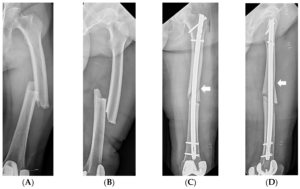Chapter 4 Selected Musculoskeletal Disease and Disorders, including Trauma and Rheumatic Disorders
Bone Fracture – Treatment and Treatment Complications
Pictures coming soon!
Zoë Soon
First Aid Treatment:
First aid for bone fractures must take place immediately and involves the following steps:
Call for an ambulance if injury is severe and/or transport to hospital by vehicle is not possible.
Carefully move person away from further danger. Cover open wound with sterile dressing.
Try not to move fracture to prevent further damage to soft tissue. Splint for support if possible/required and ensure immobilization of fracture.
RICE method involves: Rest, Ice (cold compress), Compression, Elevation) to reduce inflammation and pain.
Keep patient warm, calm, and check for signs of shock while transporting patient to the hospital’s emergency department. Signs of shock include: pallor, diaphoresis (excess sweating), hypotension, tachycardia, nausea and vomiting.
Provide emotional support.
Medical Treatment:
Treatment by the health care team will involve cleaning of the wound, realignment of the bone ends, and reduction (minimizing the gap between broken ends using pins, plates, wires, traction, casts, splints, bone grafts and/or bone cement). Traction involves applying force to maintain alignment and limited muscle spasms. The better the alignment and reduction, the greater the chance for optimal healing and full recovery. Ensuring good circulation is also important.
Electrical or ultrasound stimulation are sometimes performed to encourage bone healing.
Open wounds are often treated prophylactically with antibiotics to reduce chances of infection. At times, anti-inflammatories and analgesics are prescribed. A healthy diet is recommended, as is limiting smoking and alcohol consumption to facilitate healing.
Immobilization is maintained with casts, pins, plates etc. and no weight bearing is permitted until the bone has healed sufficiently.

Often rehabilitative exercises (e.g., stretches, physiotherapy) are prescribed and introduced when ready to maintain range of motion and encourage circulation. Once the bone has healed enough to support weight, casts can be removed and rehabilitation exercises, begin to include exercises to help surrounding muscles and joints regain strength. After months of immobilization, there will have been some muscle atrophy, and strengthening of muscle, joints and bone will typically be desired by the patient.
Often x-rays are used during the healing process to ensure that the bone is healing well and is in proper alignment.
Media Attributions
- Private: Intramedullary Pin © Joo, Y.B.; Jeon, Y.S.; Lee, W.Y.; Chung, H.J. is licensed under a CC BY (Attribution) license

